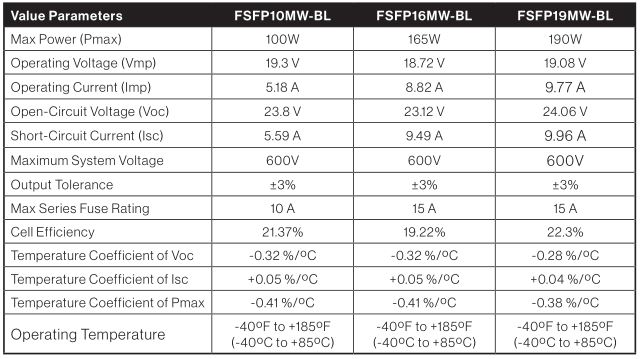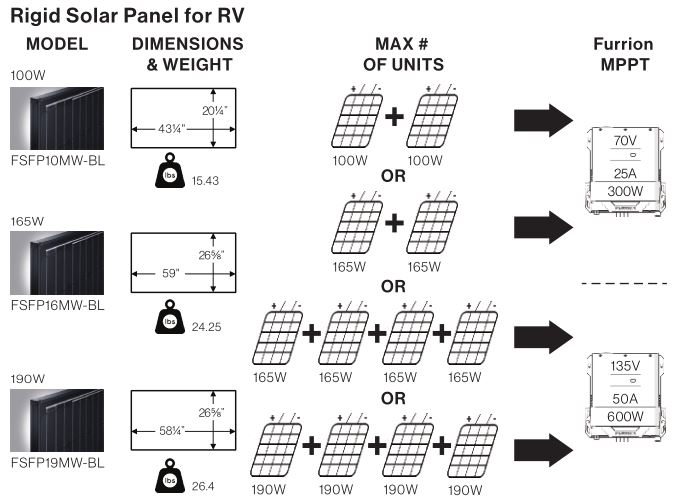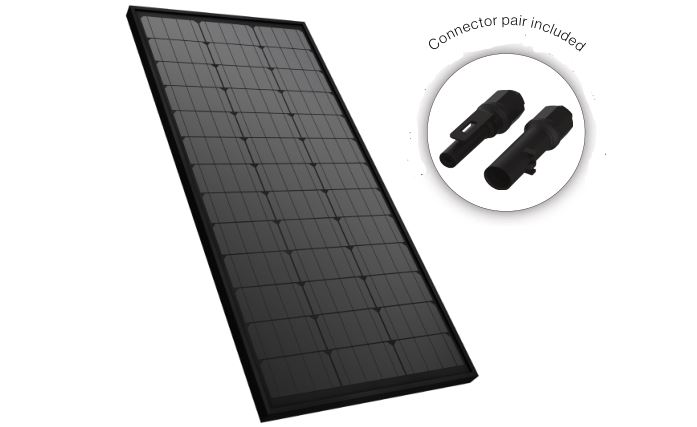FURRION Rigid Solar Panels Instruction Manual


* Picture shown here is for reference only.
Thank you for purchasing this Furrion® product. Before operating or installing, please read these instructions carefully. This instruction manual contains information for safe use, installation and maintenance of the product.
Please keep this instruction manual in a safe place for future reference. This will ensure safe use and reduce the risk of injury. Be sure to pass on this manual to new owners of this product.
The manufacturer does not accept responsibility for any damages due to not observing these instructions.
Explanation of Symbols
This manual has safety information and instructions to help you eliminate or reduce the risk of accidents and injuries. Always respect all safety warnings identified with these symbols. A signal word will identify safety messages and property damage messages, and will indicate the degree or level of hazard seriousness.
WARNINGIndicates a potentially hazardous situation which, if not avoided, could result in death or serious injury.
CAUTIONIndicates a potentially hazardous situation which, if not avoided, may result in minor or moderate personal injury, or property damage.
DANGERIndicates an imminently hazardous situation which, if not avoided, will result in death or serious injury.
Electrical Performance Parameters
Furrion solar modules are made of monocrystalline solar cells in series with high efficiency, high transmission rate, low iron tempered glass, anti-aging EVA, high flame resistant TPT laminate, and anodized aluminium alloy frames. They are designed for easy installation, extended longevity, and resistance to damage incurred by high wind or hail.

NOTE: All technical data at standard test condition (E=1000W/m² TC=25°C AM=1.5)
Mechanical Parameters



Purpose of This Guide
Please carefully read the following installation and safety instructions. Non-compliance with these instructions may void the module warranty.
This guide contains information regarding the installation and safe handling of Furrion photovoltaic modules. All instructions must be read and understood before attempting installation. If there are any questions, please contact your dealer or Furrion for further information.
The installer should conform to all safety precautions in the guide when installing modules. Before installing a solar photovoltaic system, the installer should become familiar with the mechanical and electrical requirements for photovoltaic systems. Keep this guide in a safe place for future reference.
General
- The installation of solar photovoltaic systems requires specialized skills and knowledge. The installer assumes all risk of injury, including risk of electric shock. Module installation should be performed only by qualified persons.
- All modules come with a permanently attached junction box and PV1-F 1×2.5mm2 wire terminated in PV connectors. Your dealer can provide additional extension cables to simplify module wiring.
- Exercise caution when wiring or handling modules exposed to sunlight.
- Do not connect or disconnect wires attached to photovoltaic modules when modules are exposed to sunlight, otherwise an electric arc may occur. Arcs can cause burns, fires or other safety problems. Always exercise caution when connecting and disconnecting wiring on modules.
- Photovoltaic solar modules convert light energy to direct-current electrical energy and are designed for outdoor use. Proper design of support structures is the responsibility of the system designer and installer.
- Modules may be ground mounted, pole mounted, or mounted on rooftops.
- Do not attempt to disassemble the module, and do not remove any attached nameplates or components. Doing so will void the warranty.
- Do not apply paint or adhesive to the module.
- Do not use mirrors or other hardware to artificially concentrate sunlight on the module.
- When installing modules, observe all applicable local, regional and national codes & regulations. Obtain a building and/or electrical permit when required.
Safety Precautions for Installing a Solar Photovoltaic System
- Solar modules produce electrical energy when exposed to sunlight.
- Furrion solar modules are intended to be connected in series. However, if modules or series combination of modules are wired in parallel make sure that each module or series combination of modules has the same rated voltage.
- Keep children well away from the system while transporting and installing mechanical and electrical components.
- Completely cover all modules with an opaque material during installation to prevent electricity from being generated.
- Do not wear metallic rings, watches, or other metallic devices while installing or troubleshooting photovoltaic systems.
- Use appropriate safety equipment (insulated tools, insulating gloves, etc.) approved for use on electrical installations.
- Observe the instructions and safety precautions for all other components used in the system, including wiring and cables, connectors, DC-breakers, mounting hardware, inverters, etc.
- Use only equipment, connectors, wiring and mounting hardware suitable for use in a photovoltaic system.
- Always use the same type of module within a particular photovoltaic system.
- Under normal operating conditions, PV modules will produce currents and voltages that are different than those listed in the data sheet. Data sheet values are applicable at standard test conditions only.
- Short-circuit current and open-circuit voltages should be multiplied by a factor of 1.25 when determining component voltage ratings, conductor ampacity, fuse sizes and size of controls connected to the module or system output.
General Installation Notes
- Drainage holes must not be covered with parts of the mounting system. The junction box has a breather port which must be mounted facing downward and cannot be exposed to the rain. The junction box should be on the higher side of the module when it is mounted in order to orient the breather port correctly.
- Do not lift the module by grasping the module’s junction box or electrical leads.
- Do not stand or step on the module.
- Do not drop the module or allow objects to fall on the module.
- Do not place any heavy objects on the module.
- Inappropriate transport and installation may damage the module’s glass or frame.
Mechanical Installation
Selecting the Mounting Location
- Select a suitable location for the installation of the module.
- For detailed information on optimal module orientation, refer to standard solar photovoltaic installation guides or a reputable solar installer or systems integrator.
- The module should be installed to reduce the amount of shading.
- Modules should be mounted as far away from rooftop obstructions (AC units, plumbing vents, skylights, etc.) as possible.
- If solar panels must be installed near rooftop obstructions, try to orient the modules with broadside facing the obstruction. This orientation will optimize the high by-pass diodes in shaded conditions.
- When possible, mount solar panels so that the majority of surfaces can be oriented south facing if roof is positioned accordingly.
Selecting the Proper Mounting Structure and Hardware
- Observe all instructions and safety precautions included with the mounting system to be used with the module.
- Do not drill holes in the glass surface of the module. Doing so will void the warranty.
- Do not drill additional mounting holes in the module frame. Doing so will void the warranty.
- Modules must be securely attached to the mounting structure using four mounting points for normal installation.
- Load calculations are the responsibility of the system designer or installer. The mounting structure and hardware must be made of durable, corrosion- and UV-resistant materials.
- Select mounting location such that screw holes on the mounting brackets attached to the solar panel frame are aligned with the structural framing of the roof.
Mounting Methods
- The module mounting structure must be made of durable, corrosion-resistant and UVresistant materials. Furrion recommends Z Bracket Mounting Kit, Furrion model number C-FSFP16MW-A02.
- In regions with heavy snowfall in winter, select the height of the mounting system so that the lowest edge of the module is not covered by snow for any length of time. In addition, ensure that the lowest portion of the module is placed high enough so that it is not shaded by plants or trees or damaged by flying sand.
- Modules must be securely attached to the mounting structure.
- Provide adequate ventilation under the modules in conformity to your local regulations. A minimum distance of 13/16″ (2 cm) between the roof plane and the frame of the module is generally recommended.
- Always observe the instructions and safety precautions included with the module support frames.
- Before installing modules on a roof, ensure that the roof construction is suitable. In addition, any roof penetration required to mount the module must be properly sealed to prevent leaks.
- Observe the linear thermal expansion of the module frames [the recommended minimum distance between two modules is 7/16″ (1 cm)].
- Always keep the backsheet of the panel free from foreign objects or structural elements, which could come into contact with the panel, especially when the panel is under mechanical load.
- Ensure panels are not subjected to wind or snow loads exceeding the maximum permissible loads, and are not subject to excessive forces due to the thermal expansion of the support structures.
Installation
- The module must be attached and supported by at least four bolts through the indicated mounting holes.
- Each PV module should be installed securely at minimum of 4 points. For fixed mounting, the points should be installed with M6 bolts in the frame on the long side of the panel, as shown below:

Electrical Installation
- Any hardware used must be compatible with the mounting structure material to avoid galvanic corrosion.
- It is not recommended to use modules with different configurations (grounding, wiring) in the same system.
- Solar modules must be connected in series when using a Furrion charge controller.
- The maximum number of solar panels that can be connected in series is dependent on the voltage limit of the MPPT charge controller and the open circuit voltage (Voc) of the solar panel(s) at the coldest anticipated cell temperature.
- The current, voltage, and power characteristics of the solar panel(s) will vary based on environmental criteria including temperature and solar irradiance.
- To prevent cables and connectors from overheating, the cross section of the cables and the capacity of the connectors must be selected to suit the maximum system short circuit current (The gauge of system cables is determined by the system designer or installer.).
- The maximum system voltages of the Furrion MPPT controllers is 70V (FSCC30PW-BL) and 135V (FSCC60PW-BL). The number of panels used in different configurations are depicted as below.

WARNING!Electrical shock hazard! Do not touch bare conductors or other potentially energized parts.
Maintenance
To ensure optimum module performance, Furrion recommends the following maintenance measures:
- Clean the glass surface of the module when required. Always use clean water and a soft sponge or cloth for cleaning. A mild, non-abrasive cleaning agent may be used to remove stubborn dirt. Do not clean when the panels are very hot, try to clean when the panels cool down.
- Check the electrical, grounding and mechanical connections every six months to verify that they are clean, secure, undamaged and free of corrosion.
- Caution: Observe the maintenance instructions for all components used in the system, such as support frames, PV connectors, charge controller, inverter, batteries, etc.
Shutting Down the System
- Completely cover system modules with an opaque material to prevent electricity from being generated while disconnecting connectors.
- Disconnect system from all power sources in accordance with instructions for all other components used in the system.
- The system should now be out of operation and can be dismantled. In doing so, observe all the safety instructions as applicable to installation.

Furrion Innovation Center & Institute of Technology52567 Independence Ct., Elkhart, IN 46514, USAToll free:1-888-354-5792Email: [email protected]
©2007-2019 Furrion Ltd. Furrion® and the Furrion logo are trademarks licensed for use by Furrion Ltd. and registered in the U.S. and other countries.
[xyz-ips snippet=”download-snippet”]

